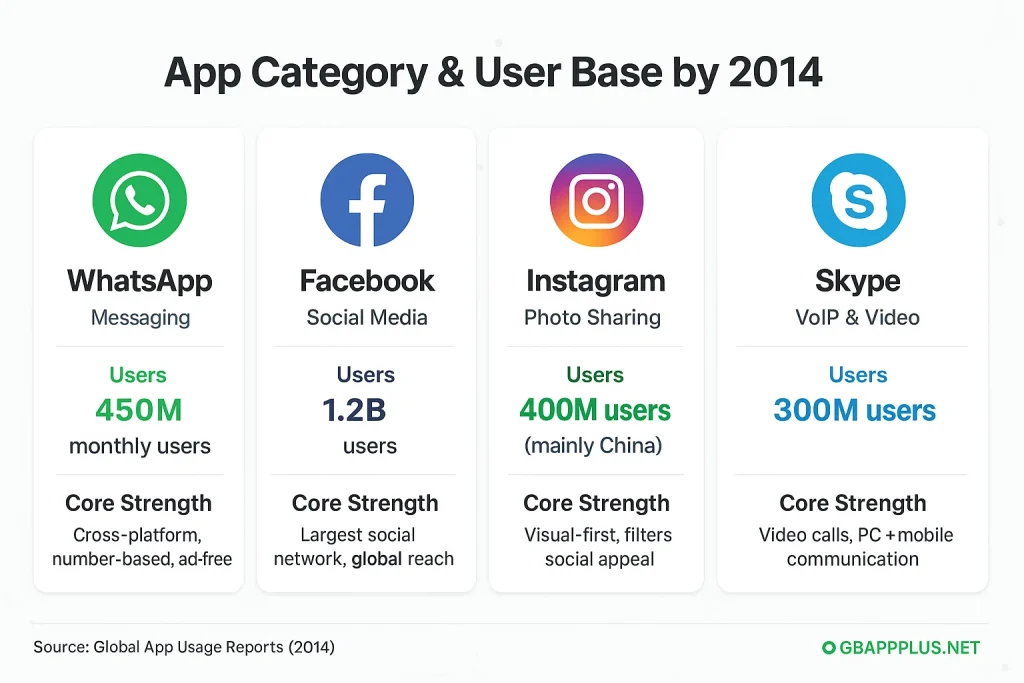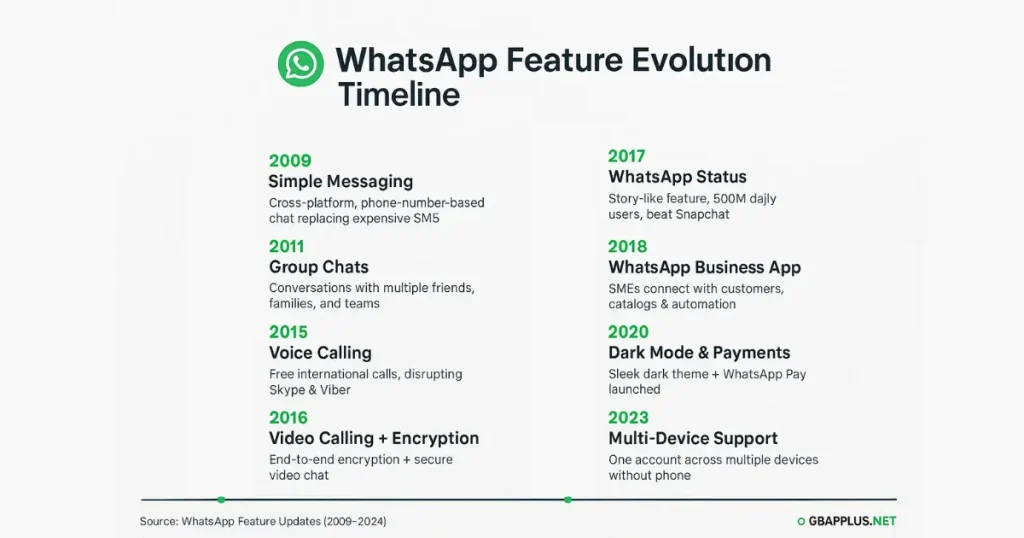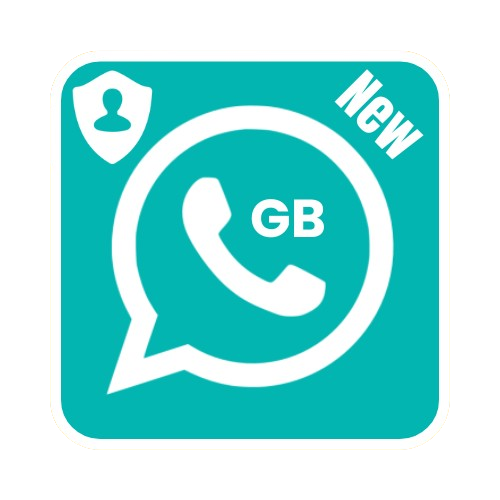WhatsApp History & Evolution: From 2009 to Facebook’s $19B Deal
Explore WhatsApp’s journey from 2009 launch to Facebook’s $19B acquisition, key features, founders, and rise as the world’s top messaging app.
When we think of messaging apps today, WhatsApp instantly comes to mind—but its journey started way back in 2009 with a very different idea. Originally built by Jan Koum and Brian Acton, the app wasn’t even about chatting at first; it was more like a status-updating tool. Over time, WhatsApp transformed into the simple, cross-platform, number-based messenger that quickly replaced traditional SMS and shook the world of communication.
Unlike older apps like BBM, MSN, or Yahoo Messenger, WhatsApp’s strength came from being mobile-first, ad-free, and easy to use. It worked across different phones, relied only on your phone number (no usernames or PINs), and delivered real-time messages using push notifications. That simple yet powerful framework helped it stand out—and eventually made it the most popular messaging app worldwide.
Educational Background of Developers and Initial Days of WhatsApp
WhatsApp was founded by Jan Koum and Brian Acton, two former Yahoo engineers with very different educational paths. Jan Koum, originally from Ukraine, studied computer science at San Jose State University but dropped out in his early semesters to focus on practical work. He later worked as a security tester before joining Yahoo in 1997. On the other hand, Brian Acton graduated in computer science from Stanford University in 1994 and went on to work at Apple, Adobe, and then Yahoo, where he met Koum. Their shared experience at Yahoo—over a decade of handling servers, security, and infrastructure—became the backbone of WhatsApp’s technical reliability.
When WhatsApp launched in 2009, it was a very different app compared to what we know today. At first, it allowed users to update their status, not chat. The turning point came when Apple introduced push notifications, enabling real-time message alerts. Koum and Acton coded the early versions themselves, later bringing in a very small team. Unlike many Silicon Valley startups with large engineering staff, WhatsApp kept things lean—fewer than 50 engineers even when it had hundreds of millions of users.
In the first year, WhatsApp gained only a few hundred thousand users, with revenue coming from the $0.99 App Store fee. Its growth was steady, not an overnight explosion. The appeal was simple: a cross-platform, number-based messenger that saved people from costly SMS charges. This combination of technical expertise, lean development, and word-of-mouth adoption set the stage for WhatsApp to later become the world’s most popular messaging app.
WhatsApp’s 2009 to 2014 Era, Funding, Popularity Graph and Competition with Other Apps
When WhatsApp launched in 2009, it wasn’t backed by big investors or flashy campaigns. In fact, Jan Koum and Brian Acton funded the app with their own savings from years at Yahoo. For the first year, they managed everything themselves before securing their first external funding in 2011 from Sequoia Capital ($8 million). Two years later, in 2013, Sequoia added another $50 million, giving WhatsApp enough fuel to handle its rapidly growing user base. Unlike many Silicon Valley startups, WhatsApp stayed lean with a very small engineering team—yet managed to scale globally.
Between 2009 and 2014, WhatsApp evolved from a status-update tool to a full messaging app with group chats, multimedia sharing, and voice notes. Its design stayed minimal and ad-free, which users loved. The growth was steady at first: just a few hundred thousand users in 2010, 50 million by 2011, and then an explosive climb to 450 million monthly active users by early 2014. This viral adoption was powered by word-of-mouth, especially in regions where SMS was expensive, such as India, Latin America, and Africa.

WhatsApp wasn’t alone in the race. Facebook was dominating social media with over a billion users, while Instagram became the top photo-sharing app with 150 million users by 2013. In China, WeChat grew to 400 million users by 2014, offering not just messaging but also payments and mini apps. Skype held around 300 million users, mainly for video calls, while BBM and Viber tried to compete but couldn’t match WhatsApp’s simplicity. By keeping its focus clear—fast, reliable, cross-platform messaging without ads—WhatsApp became the world’s leading messaging app by the time Facebook acquired it in 2014 for $19 billion.
| App | Category | Users by 2014 (approx.) | Core Strength |
|---|---|---|---|
| Messaging | 450M monthly users | Cross-platform, number-based, ad-free | |
| Social Media | 1.2B users | Largest social network, global reach | |
| Photo Sharing | 150M users | Visual-first, filters, social appeal | |
| Messaging + More | 400M users (mainly China) | All-in-one: chat, payments, mini apps | |
| Skype | VoIP & Video | 300M users | Video calls, PC + mobile communication |
Facebook’s Acquisition (2014) and Deal Financial Insights
In 2014, Facebook made headlines by acquiring WhatsApp for an astonishing $19 billion, the largest tech deal of its time. The move wasn’t just about buying a messaging app—it was about securing dominance in global mobile communication. WhatsApp had already become the go-to platform in markets like India, Brazil, and parts of Europe, and Facebook saw more value in owning it than trying to compete directly with Messenger.
- Deal Structure: $4 billion in cash, $12 billion in Facebook shares, and $3 billion in restricted stock units (RSUs).
- Jan Koum’s Payout: Around $6.8 billion in cash and stock, plus a seat on Facebook’s board.
- Brian Acton’s Share: Roughly $3.5 billion.
- Sequoia Capital’s Gain: Turned a $60 million investment into nearly $3.5–3.8 billion.
- Employee Rewards: Around 50 staff members shared $3 billion in RSUs, making many instant millionaires.
- Taxes: Founders faced 20–25% federal capital gains tax, plus state taxes—meaning Koum alone likely paid over $1.5 billion in taxes.
Critics initially claimed Facebook had overpaid, but history proved otherwise. By 2024, WhatsApp had over 2.7 billion users and evolved into a key revenue engine through WhatsApp Business and payment features. What once looked like a gamble is now viewed as one of the smartest acquisitions in Silicon Valley history.
Evolution of WhatsApp as a Global Messaging Leader under Facebook
When Facebook acquired WhatsApp in 2014, many people doubted if the deal was worth a record-breaking $19 billion. Fast forward to today, and WhatsApp has grown into the world’s most used messaging app with over 2.7 billion users, shaping how billions communicate daily. From free SMS replacement to business transactions, payments, and even e-commerce, WhatsApp’s journey under Facebook (now Meta) is nothing short of revolutionary.
Key Phases of WhatsApp’s Evolution under Facebook
- Massive User Growth: In 2014, WhatsApp had ~450 million active users. Within just two years, it crossed the 1 billion user milestone—a pace even faster than Facebook itself.
- Voice & Video Calls (2015–2016): A game-changer. WhatsApp wasn’t just for text anymore—it started replacing international calling apps like Viber and Skype.
- End-to-End Encryption (2016): Surprised many when WhatsApp, backed by Facebook, rolled out full encryption by default—making it one of the most secure global platforms despite privacy concerns.
- WhatsApp Status (2017): Inspired by Snapchat Stories, this feature shocked skeptics by gaining 500 million daily users, almost double Snapchat’s entire user base.
- WhatsApp Business (2018): A quiet but powerful move. Today, over 200 million businesses use WhatsApp to connect with customers, making it the backbone of local commerce in countries like India and Brazil.
- Payments Integration: WhatsApp Pay rolled out in India and Brazil, turning the app into a mini financial ecosystem for millions.
- Less-Known Fact: WhatsApp’s engineering team remained surprisingly small (under 60 engineers for years), yet managed to handle billions of daily messages thanks to highly efficient code.
WhatsApp is no longer “just an app.” In regions like India, Africa, and Latin America, it is the internet for communication and business. Many small businesses don’t even use websites—they rely solely on WhatsApp catalogs and payments. Its deep integration into people’s lives has made it a social utility, not just software.
While competitors like Telegram and Signal target privacy-first users, WhatsApp’s simplicity, massive network effect, and Facebook’s resources have made it nearly impossible to dethrone. In fact, what once looked like an overpriced acquisition is now seen as one of the greatest tech investments ever made.
Major Features and Innovations Over the Years
WhatsApp’s journey is not just about user growth—it’s about how the app kept adding powerful yet simple features that changed the way people communicate. From text-only chats in 2009 to voice, video, business tools, and payments, each feature rolled out at the right time, making WhatsApp a true global leader in messaging apps.

- 2009 → Simple Messaging: Cross-platform, phone-number-based chat replacing expensive SMS.
- 2011 → Group Chats: Enabled conversations with multiple friends, perfect for families and work teams.
- 2013 → Multimedia Sharing: Photos, audio, and video support boosted user engagement.
- 2015 → Voice Calling: Made international calls free, disrupting apps like Skype and Viber.
- 2016 → Video Calling + Encryption: Secure end-to-end encryption introduced; video chat became mainstream.
- 2017 → WhatsApp Status: Story-like feature, quickly hit 500M daily users, even beating Snapchat.
- 2018 → WhatsApp Business App: Allowed SMEs to connect with customers, share catalogs, and automate responses.
- 2020 → Dark Mode & Payments: Added popular design update + WhatsApp Pay launched in India & Brazil.
- 2021 → Multi-Device Support: One WhatsApp account across multiple devices without phone dependency.
- 2023 → Communities: Organized groups into hubs for schools, workplaces, and organizations.
- 2024 → AI-Powered Chat Tools: Smart replies, business automation, and AI-driven features rolled out gradually.
Rise of WhatsApp Mods – Benefits and Concerns
In recent years, WhatsApp Mods like FM WhatsApp, GB WhatsApp, and Yo WhatsApp have gained attention among users who want more customization and features than the official app provides. These modified versions often allow advanced privacy settings, unique themes, message scheduling, and extended file sharing limits, making them attractive to power users who want more control.
However, WhatsApp Mods also raise serious concerns around security, data privacy, and account bans. Since they are not official and bypass WhatsApp’s strict policies, users risk malware infections, data leaks, or permanent suspension of their accounts. While the mods may look appealing, experts always recommend sticking with the official WhatsApp app to ensure safety, reliability, and long-term support.
WhatsApp’s Global Impact and Future Outlook
Today, WhatsApp is more than just a messaging app—it’s a digital lifeline for over 2.7 billion users worldwide. In countries like India, Brazil, and large parts of Europe, WhatsApp has become the primary way people communicate, share news, and even run businesses. Reports show that over 100 billion messages are sent daily, and WhatsApp Business now powers millions of small and medium enterprises, proving its impact goes far beyond personal chats.
Looking ahead, WhatsApp is focusing on AI-driven features, payments, and stronger business tools. With Meta’s vision of integrating WhatsApp into the broader ecosystem (alongside Facebook and Instagram), the app is likely to play a central role in e-commerce, customer service, and secure digital identity. While challenges remain—like privacy debates and competition from Telegram, Signal, and WeChat—WhatsApp’s scale and adaptability suggest it will continue to be a global leader in messaging for years to come.
Conclusion
From its simple start in 2009 to becoming a global leader with billions of users, WhatsApp has reshaped the way the world communicates. Built by Jan Koum and Brian Acton, the app stood out by offering SMS-free, cross-platform messaging at a time when competitors struggled with complexity. Its steady growth, Facebook’s record $19B acquisition, and feature rollouts like voice, video, and end-to-end encryption marked milestones in its journey.
While WhatsApp Mods highlight user demand for customization, they also raise concerns around privacy and security. At the same time, WhatsApp under Meta has expanded into business, payments, and AI-driven tools, showing that it is no longer just a chat app but an evolving ecosystem.
In short, WhatsApp’s story is not only about technology but about how human connection has transformed in the digital age—and it continues to shape the future of global communication.
